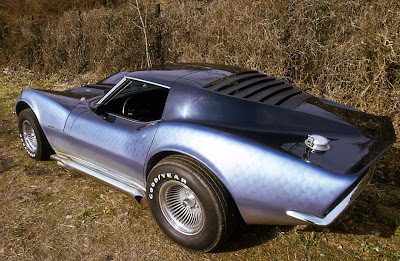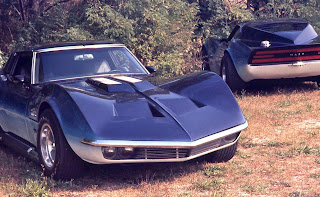Motion's Joel Rosen cloned the star-power appeal of GM’s Mako Shark II Concept to create and market the ultimate street/show Corvette.
Motion-built Shark show car, top, German-built Motion Shark in pits at Zandvoort GP track in Holland, 1978.
Few concept cars, since the genre was essentially invented by GM’s Harley Earl (1938 Buick Y-Job), have equaled the 1965 Corvette Mako Shark II’s ability to elicit emotional responses at auto shows. It was such a powerful drawing card for Chevrolet and General Motors that it was maintained in its original configuration until the 1969 model year. That’s when it morphed into the Manta Ray, the next generation Corvette Concept.
While the Gen I Shark II was shown first (April, 1965, New York International Auto Show) with a 396/425 big block and radical outside exhausts, the second generation Shark II Concept, shown for the first time in October, 1965, had undercar exhausts and the new-for-1966 427 Corvette engine. It was its paint job that put the slick Shark in a class by itself.
First two Motion-built Sharks, with '69 Corvette outside exhausts, ready to deliver to customers.
GM stylists effectively captured the actual color and shading of a real shark via the selection of unique Fire Frost lacquer. Starting with black at the roofline, the color gradually started turning dark blue down the sides of the body, ending in light gray along the rocker panels. Harley Earl’s successor, William Mitchell, VP, GM Design, championed this car and supplied a real shark’s skin to the painters to insure the accurate replication of color and shading.
Motion's front end design incorporated French Cibie headlamps.
During 1965 and 1966 new model Chevrolet introductions, the Mako Shark II wowed auto show goers, both here and abroad. It received rave reviews in Paris, London, Brussels, Geneva and even, Turin, Italy’s automotive design capital. It represented a quantum leap in automotive styling and had a profound influence on 1968 to 1982 Corvette design.
To avoid confrontation with GM, Motion’s Joel Rosen chose not to faithfully reproduce the Shark II body or to use “Mako” badging. The Motion Maco Shark retained the basic styling cues of the original, including the domed tilt front end, tapered and louvered backlight, right, and signature exterior finish. Gary "The Local Brush" Kupfer applied the Shark paint scheme.
Instead of retaining the concept car’s flip-up headlamps common to Corvettes of the period, Rosen designed a smoother front-end treatment incorporating Cibie rectangular headlamps neatly tucked into the grille cavity. And, like the Shark II prototype, the Motion Maco Shark sported aggressive outside exhausts. Rosen started with ’69 Corvette outside exhausts and later switched to chromed outside header exhausts.
One of the more interesting examples of Motion’s execution of a Shark is one we photographed at the 1978 Swiss Corvette Club International (SCCI) Euro Meet at the Zandvoort GP track in Holland. Owned by Michael and Connie Pottkamper, it was built in 1977 in Germany using a Motion Shark Kit. It was actually constructed on a barge docked on the Rhine River! Unlike many that were built as show cars, the Pottkamper Shark, below, was built for road and track use.
Unlike the factory Manta Ray iteration of the Mako Shark II, which was a technical/electronic Tour De Force as well as a head-turning show car, Motion’s Shark was a down-to-earth high-performance street Corvette. Maco Sharks built by Motion were powered by naturally aspirated as well as boosted 350 small-blocks to 480-inch stroked big-blocks. Luxury options were available as well.
Most Sharks were built for street driving. Some, however, were full-tilt show cars that did a fair share of trophy collecting. One such Shark, below, originally built for Anthony Dedentro, Jackson Heights, NY, represented a typical Motion show car build.
Delivered on November 2, 1974, it was built on a 1970 Corvette chassis and powered by a brand new 350 engine. This air conditioned and full-power Shark also sported a diamond-tufted custom interior and a one-of-a-kind taillight treatment with individual “bubble” lenses in place of the one-piece slotted panel lighting. At $17,039.75, it was one of the most expensive Maco Sharks built by Motion. It now resides in Dan McMichael’s collection in Indianapolis, IN.
Custom Motion Shark with "Whale Tail" photographed at GP track in Belgium, circa 1980-'81.
Motion built Maco Sharks to order between 1971 and 1978. Conversion kits were also marketed for do-it-yourselfers and custom body shops. Kit sales lasted well into the 1980s and records show that hundreds of kits were produced for domestic as well export sales. A number of Shark conversion kits were shipped to enthusiasts in Germany and Switzerland.
GM’s Manta Ray is still powered by a 1969 all-aluminum ZL-1 big-block and calls the General Motors Heritage Center, Warren, MI, home. It’s ironic that if you’d like to see what made the Mako Shark II one of the greatest show cars of all times, you would have to find one of Joel Rosen’s Motion Sharks, above. The factory original lost its identity when it became the donor car for the Manta Ray Concept!
Motion’s Maco Shark Corvettes are covered in MOTION, Tales Of A Muscle Car Builder published by Motorbooks and available at, http://www.amazon.com/Motion-Performance-Tales-Muscle-Builder/dp/0760335389








